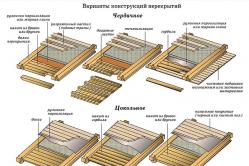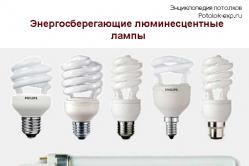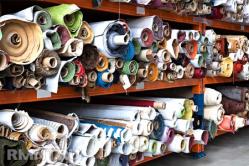Antipyretics for children are prescribed by a pediatrician. But there are situations of emergency care for fever, when the child needs to give the medicine immediately. Then the parents take responsibility and apply antipyretic drugs. What is allowed to give to infants? How can you bring down the temperature in older children? Which medications are the safest?
Many private developers, after building a house, start to think about how to cheaply rent houses.
Each owner wants to see his construction with a quality and attractive exterior finish, but exclusive finishing materials are not cheap.
The budget of not every family can withstand such expenses.
But you should not choose the most budgetary options for finishing the facade, because rain, wind and snow can quickly render unfit for poor quality material on the facade. It's cheap to make a house lining, in any case it does not work out, but you can find the best option, with good characteristics and at an affordable price.
There are several types of facing materials that private developers prefer, for example:
- facade plaster
- porcelain stoneware
- decorative brick
- painted facade primer
- block house
The main factor influencing the choice of facade material is its durability and wear resistance. And in order to understand which cladding is needed in this or that case, it is worthwhile to thoroughly consider the most popular types of materials.
Facade plaster
This material for finishing facades, which has a number of advantages:
- inexpensive price
- a wide range of colors
- simple method of application
- guaranteed beautiful decoration
- on the market you can buy varieties of plaster, which have heat-insulating and soundproofing properties with a water-repellent effect
Naturally, there is no such material that would be devoid of shortcomings.

On the facade plaster may appear cracks and stains, from the adverse effects of the external environment. If the technology of applying the material has not been violated, the facade will require an update for the third year.
Types of siding
For the cladding of private houses, two types are often used: vinyl and metal, each has its own advantages and disadvantages.
Vinyl Siding
This material has become popular with private developers due to their positive characteristics:
- simplicity of arrangement
- affordable price
- durability, does not change its properties for more than 20 years
- thanks to a small mass, does not exert additional loads on the base
- large selection of colors
- suitable for facing private buildings of any material
- ease of care
- sheets of material can simulate any surface, from wood, to natural stone
Despite the fact that vinyl siding has unimportant drawbacks: low impact resistance and the possibility of gaps when the design is unstable is the best option for finishing the facade.
Metal siding
Do not know how to cheaply rent a house in the country? Ideal option may be aluminum siding, the material of which has many positive aspects:
- fire safety
- durability and durability
- large selection of colors
- resistance to ultraviolet rays
- affordable
- easy to install
Lack of this material, one - with a strong impact, metalosiding is deformed without the possibility of restoration. But for the casing of the cottage, it is quite suitable.
Advice! In order for the facade of the siding to last a long time, the lower part of the structure is better lined with metal siding for the socle, which has an increased wear resistance. The whole house is not recommended for finishing them - the material has a large specific weight.
Porcelain tiles
Ceramic granite - a kind of facade material, which is considered to be an alternative to natural stone, it has many advantages:
- durability
- strength
- ease of care
- excellent design characteristics
- resistance to fading
The main disadvantages of this material are: the complexity of the work to be done in several stages and a high price.
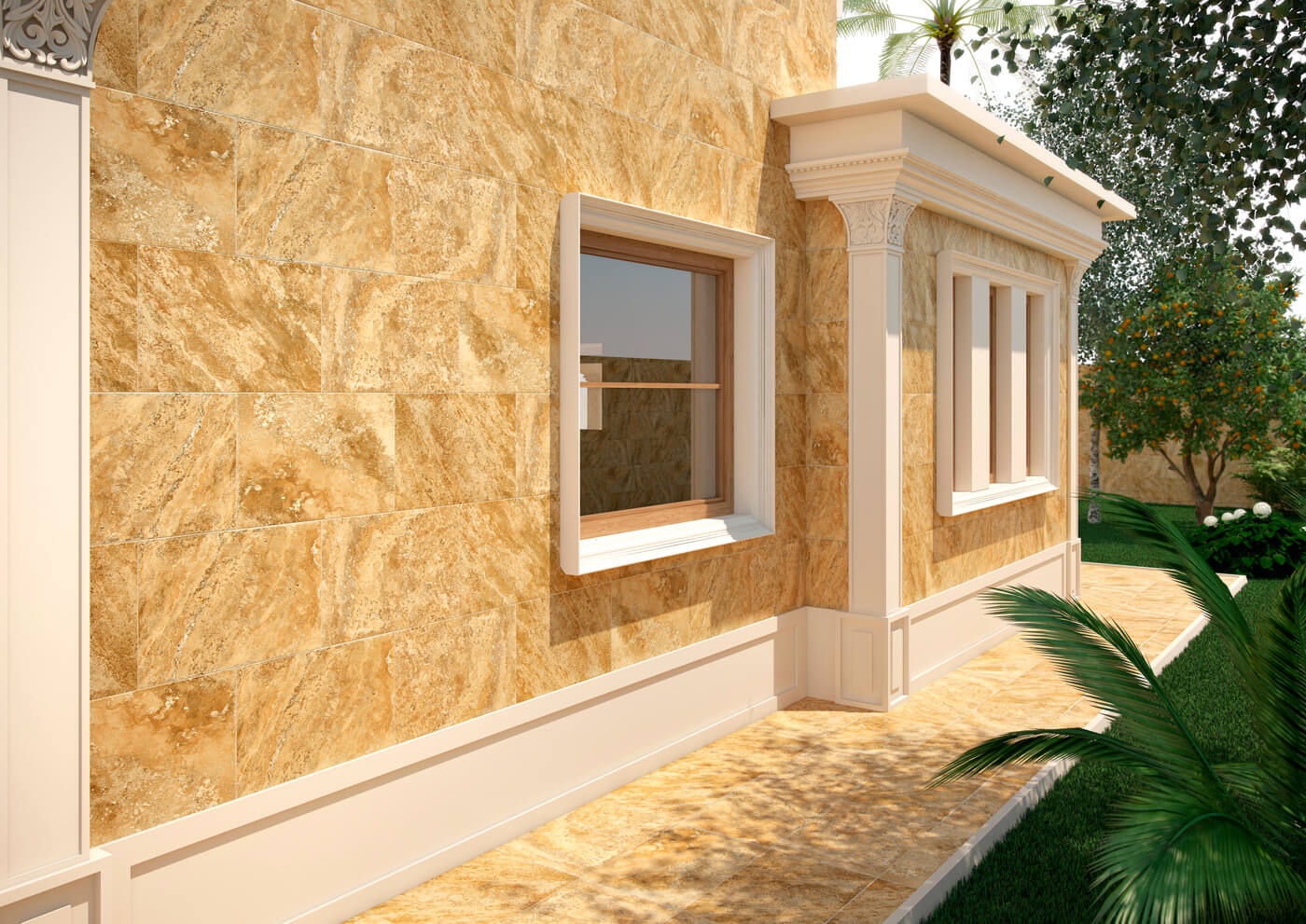
Answering the question: the less expensive to decorate the facade of the house and it is beautiful, it is worth using porcelain stoneware, which is particularly strong, while the thermal insulation qualities are much greater.
Ceramic brick
Ecologically clean material produced from natural ingredients. The advantages of pottery bricks include:
- you can choose the variations for any style
- excellent thermal insulation properties
- ability to color in any tone
- is not afraid of the influence of the environment
- lasting
- durable
Among the shortcomings, it can be noted: it takes a very long time to complete the cladding, you need to comply with the temperature regime.
Finished facade primer
If the walls of the house were plastered in advance, then the cheapest option to make the facade attractive - cover it with a facade primer. For private buildings it is recommended to apply a deep penetration primer.
This material can be covered with a wooden frame, pre-sanded each log, only the soil-impregnation should contain antiseptic components in its composition.
Block house
This is a natural wooden board with one semicircular side - an imitation log. The material has proved to be well established with private developers, as the structure of the block-house lined with lamellas has a magnificent appearance. The material is made from natural raw materials using innovative technology, which allows it to maintain its positive qualities for many years.
Block house has the following advantages:
- environmental friendliness
- strength and lightness
- resistance to temperature changes
- convenient installation
- creates a special microclimate in the house - the material "breathes"
- affordable cost
The material is universal, they can be lined not only the outside of the walls of the house, but also the room inside.
Having considered all kinds of the most common materials and their characteristics, you can choose the best option for yourself. But do not save too much on the lining of the house, because the type of structure should be beautiful and delight the owner.
On the video - inexpensive and original facade of the house - on video:
Found an error? Select it and press Ctrl + Enterto let us know.
Everyone knows that building a house is only half the battle, it still needs to be "dressed". When choosing clothes (exterior decoration materials) it is necessary to show good taste and practicality. So, than to finish the facade of the house is a question that we asked specialists.
There are many options for finishing the facade, and therefore there can be many ways of decorating.
Modern building production provides many options for finishing the facade: stone thermo panels, siding, plaster.
Finishing the facade with plaster
Enjoys high popularity. The building segment offers cement-sand and various decorative plasters, allowing to apply to the walls a variety of patterns and textures.
Plaster can create a relief or smooth surface of the facade walls. It is important to know that plaster walls increase the fire resistance of a building, improve its heat and sound insulation.
The most common today are - cement-sand, facade (silicone, acrylic) and decorative (mosaic, "under the fur coat" and others).
Cement-sand plaster contains sand, cement and chemical additives. It is used on surfaces that are constantly exposed to high and low temperatures, as well as on walls constantly exposed to high humidity.
Acrylic - the most affordable form it allows you to create a durable coating based on expanded polystyrene.
The disadvantage of acrylic plaster is the lack of elasticity, even with insignificant temperature changes on the surface there are microcracks.
Silicone plaster is made on the basis of silicone resins and is a polymer coating. It is waterproof, water repellent and does not accumulate moisture, resistant to ultraviolet, temperature drops are not terrible for it, has a long service life.
The main feature of decorative plaster is the fact that it imitates more expensive types of decoration. This effect is achieved by adding quartz sand, pigments, stone or granite chips of various sizes to the composition.
As for the colors used, it is necessary to know that for unfavorable (including severe) climatic conditions and industrial areas, it is better to choose acrylic paints. They are more resistant to different climatic influences, quickly dry and can provide a durable coating with good vapor permeability.
Stone Finishing

Facade decoration with facing stone
The stone is the most reliable and strong material, its longevity can only be envied. For finishing the facade use both natural and artificial stone, which often in its quality and appearance is in no way inferior to natural.
The texture, color, size and rock of the facing stone are determined by architectural tasks. For example, buildings, lined with diorite or granite, look more strictly and monumentally than buildings lined with marble and travertine.
The natural stone will provide durability, strength and resistance to climatic influences. When choosing it is important to pay attention to the frost-resistant properties of the stone, since for a severe climate this factor plays a key role.
Artificial stone has a more democratic value, but not inferior in the range of colors, textures and shapes. In addition, it is lightweight, anti-corrosion and wear-resistant.
Finishing with thermopanels

Facing with thermal pane
Thermal panels are almost completely finished facade, with many advantages.
First, they use high-density polystyrene - the best heat insulator that keeps cool in the summer and does not release heat in the winter.
Secondly, thermopanels are lightweight, so they are used for buildings with a light foundation and floors.
Thirdly, even despite their light weight, they have high strength.
And, fourthly, thermopanels are environmentally friendly material based on polyurethane foam and clinker tiles.
Installation of thermal panels is carried out with the help of screws or dowels, which allows them to be installed on almost any surface (concrete, brick or wooden).
Another advantage is that they are easy to install and can be installed at any time of the year.
The most popular are thermopanels with clinker tiles "for brick", imitating brickwork, but, interestingly, significantly surpassing it in terms of technical characteristics.
Ventilated facade
Specificity of the ventilated facade
Ventilated facade - a kind of "layered pie", in which between the heater of the outer wall and the facing material is the air space. In other words, it is a hinged structure, which is installed at a certain distance from the wall.

Ventilated facade
Note! It allows the walls to let in air, while excess moisture is diverted to the ventilated zone, from which the rising air flows out.
Choice of cladding
As a facade for a ventilated facade, various materials can be used: from a light aluminum composite sheet to a heavy granite slab. Such facades have very high energy-saving properties, and can also provide excellent sound and noise insulation of walls.
The main advantage of ventilated facades is that they do not require preliminary wall preparation, in addition, the hinged elements can close any defects and uneven walls.
Siding

Facing the house with vinyl siding (price - from 198 rubles.)
One of the most commonly used options in modern decoration. In translation from English, "siding" means "skin".
What are the types of siding and how to finish the house with siding?
Siding can be socle, vinyl, wooden and metal.
- The socle siding is used mainly for finishing the basement of the building. Install panels with a thickness of more than 3 mm, imitating natural building materials (stone, facing brick).
- Ground siding - a durable material that provides a long life, protects the socle from external factors and hides the disadvantages of the surface.
- Traditional vinyl siding is made of polyvinyl chloride (PVC), which is very resistant to all mechanical damage. The main disadvantage of vinyl siding is its increased sensitivity to ultraviolet radiation. Therefore, when choosing a siding, they often try to avoid bright saturated colors, preferring pastel colors.
- Wooden siding is the most expensive kind, because for its production use natural wood. Wooden siding - environmentally friendly and aesthetic material, but, unfortunately, short-term.
- Metal siding is very durable and resistant to external factors. They are often lined with farm buildings or industrial buildings.
Wet facade

Facing «Wet facade»
This technology is a multi-layered facade design, each part of which performs certain functions.
In standard form, the "wet facade" system consists of three layers: reinforced (basic), heat-insulating and external (decorative) layer.
- The reinforced layer ensures the smoothness of the outer wall and fixes the heat-insulating material. Consists of reinforced mesh and glue composition.
- The thermal insulation layer consists of heat-insulating boards, which have a low thermal conductivity. Usually such plates are made of mineral wool or polystyrene foam.
- The decorative layer is made of plaster (silicone or mineral) and performs simultaneously two functions - decorative and protective.
The answer to the question, how to finish the facade of the house depends on many factors, among which the financial side and personal preferences are not the last.
Summing up
We hope that our article was useful to you. In order to more accurately understand the technological and practical issues, our website provides a detailed photo and video instruction, in which you will find useful information on this issue.
- Facade, ventilated - in this case, there is a gap between the façade itself and the outer wall, this gap helps to create a constant flow of air between the facade and the wall, thereby moisture does not accumulate.
- Wet or non-ventilated facade - this is a set of facing layers, this includes a layer of insulation, plaster reinforcing mesh, plaster and primer, applied in several layers, on top lining materials and, possibly, paint. Many layers of different materials that do not give the building a "breathe" that's why this method is called "wet".
- plaster silicone (acrylic);
- cement-sand mortar;
- decorative plaster of mosaic type or "under a fur coat".
- Plaster has a high level of thermal stability, due to which it is protected from the possible appearance of cracks and chips.
- Has good moisture resistance.
- The plaster has good adhesion, tightly adheres to the wall, due to which it protects the walls of the house from the wind.
- The walls of the house "breathe" and draw moisture out, excluding condensation.
- Protected against harmful UV rays.
- Durable. The average service life of the facade plaster is more than 30 years, but only if the facade is painted every 6 years.
- For the plastering, do not require the services of a professional master, everything can be done independently.
- Light weight. Due to the light texture, the plaster does not create an additional load on the walls.
- A wide range of options and color solutions.
- Ecologically clean composition of plaster materials.
- Fire resistance.
- Very durable and reliable material.
- The use of bricks eliminates the need for waterproofing the walls, since the brick is waterproof.
- Protects the house from the wind.
- A simple installation process that does not require the use of a large number of tools.
- Not exposed to chemicals.
- It is fireproof.
- Produced from environmentally friendly materials.
- Elegant, stylish and luxurious appearance. A special glazed stone with a smooth surface, or a stone with a pattern, etc., is also used.
- The ability to use an artificial stone, which looks no worse and is much cheaper.
- The stone is suitable for wooden, brick and concrete facades.
- Ability to create any drawing and design.
- Concludes both a heater and a facing layer.
- Suitable for installation at any time of the year.
- Thermal plates are frost-resistant and not subject to negative natural factors.
- Pleasant value and elegant appearance.
- Siding ground - it is best to use specifically for the basement of the house. These panels have a dense texture and a thickness of more than 3 mm. The appearance of such a siding often imitate stone or brick. Has a long service life and well protects the building from weather conditions, hides all the unevenness and shortcomings of the walls.
- Vinyl Siding - very elastic material, due to which it perfectly withstands any mechanical damage. But this option is not suitable for installation in the cold season. It is exposed to UV rays, so you will not show much imagination in decorating a building, any color will very quickly burn out in the sun.
- Wooden siding - a rather expensive option of finishing, as for its production is used natural wood. Despite the fact that the material is environmentally friendly, it is very short-lived.
- Metal siding - a durable and resistant version, which protects the facade from a variety of factors. But it is suitable only for industrial and household buildings.
When building and repairing a house, one of the most important items is the proper selection of a good exterior finish for the building. The choice of finishing materials for the facade plays not only a functional and technical role, it is also very important to choose a material that will look good and emphasize the owner's taste.
Than to finish a facade of the house? This is the most exciting issue for many users, because the choice of options for facing the walls and also ways to decorate the appearance of the house is also very much. The main thing is to remember that decorative functions, although they play not the last role, but it is not worth forgetting about technical features.
It is necessary to combine the beautiful facade of the house with the quality of the material
Sheathing can be completely different in properties, texture, method of application and installation, it can be as ready-mixed with dyes, and slabs, stone. The main requirements for any cladding material are strength, reliability and presentable appearance. It should be clarified how much the material selected by you will protect the facade of the building from weather conditions, humidity, snow, sun, temperature changes. Remember that a good sheathing, must perform three main functions - thermal insulation, soundproofing and waterproofing.
What you need to know when choosing a facing material
The paneling for the facade is divided into two categories, for ventilated facades and non-ventilated facades. Unventilated facades refer to wet.

Wet, non-ventilated facade
If you live in a city with a warm climate, it is not necessary to install an additional heater. Sheathing for facades of any type is perfectly applied and fastened without a layer of insulation, immediately on the walls of the building. These are the main points, you should consider choosing the right facing material for the facade. Let's consider the most popular materials for facade cladding, their pros and cons.
Facing the house, what material is better?
Than to finish a facade of the house, each user solves, relying on personal preferences and opportunities. Someone is looking for more inexpensive stuff, and someone is hunting for quality and beautiful appearance. The most important point when choosing is that the result of the work you completely satisfied.
Most popular facing materials
Plaster
Stucco, a fairly cheap option for facade cladding is quite popular and at the moment there are many interpretations of it. Such a shell allows you to depict various drawings on the walls and embody many decorative ideas. This kind of cladding material is used to create a smooth or embossed surface. Plaster has a good level of fire safety, and also creates a good noise and thermal insulation.

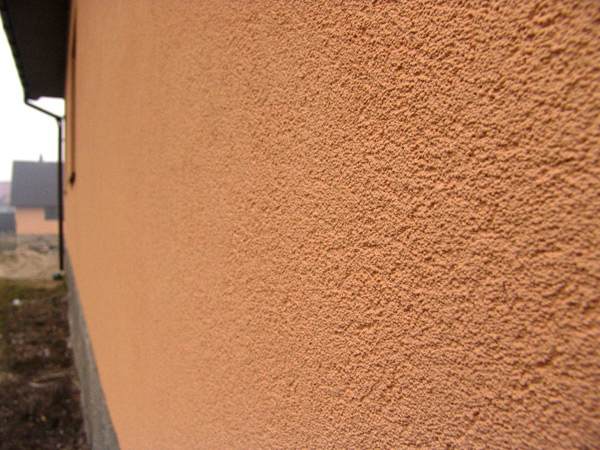


One of the best varieties of this building material, we can consider:
Pros of plaster, as facing material:
The disadvantages of plaster can be attributed, poor thermal insulation, as well as the rapid destruction of the layer, in the event of exposure to it, any aggressive chemicals. Needs care and quickly loses an attractive appearance.
Brick
The brick has been used for facade cladding for many decades. A house made of bricks is a classic. This material is durable, durable, makes the construction complete, protects the walls of the house from any weather conditions.








Pros of this material:
A rock
Stone is not only the most durable material, but also creates a beautiful unique design. For cladding is used not only natural stone, the cost of which can be quite high, so you can use an artificial substitute. The stone opens up a lot of design options for the user. You can find a large selection of colors, shapes, textures and rocks. Choosing the right one, depends on your needs and on the quality of the walls of the house.


![]()





Advantages of stone:
The disadvantages of this material, you can include a lot of weight. Because of the rather large mass, the stone can not be used on dilapidated walls or in the case when the weighting will have a bad effect on the entire structure.
Thermopanels (clinker plates)
This material has a huge number of advantages and advantages. This is a completely finished material, which includes both the insulation and plaster and the finished material at the same time. Thermal panels are easy to install, the process does not take much time, since it is already finished material, it only needs to be fixed to the facade of the building.








It has excellent thermal insulation, keeps warm in winter and a pleasant coolness in summer. They have a small weight, due to which they are suitable for installation on any building. Excellent leveling of the walls and suitable for building reconstruction. The material is protected from fire and is made of environmentally friendly components, it perfectly passes air, does not lose its appearance and is able to last more than 30 years.
There is a huge choice of thermopanels of any colors, textures and designs. You can choose for your façade a thermo-plate with an imitation of brick or stone, etc.
Pros:
Siding
If you are looking for cheaper material, then pay attention to siding. They can inexpensively trim the facade of the building, create an acceptable appearance. It perfectly hides the shortcomings of the walls, the installation is very easy to make and moisture resistant and quite durable material. There are a lot of siding species, you can choose one that will look more harmonious with your facade.
![]()

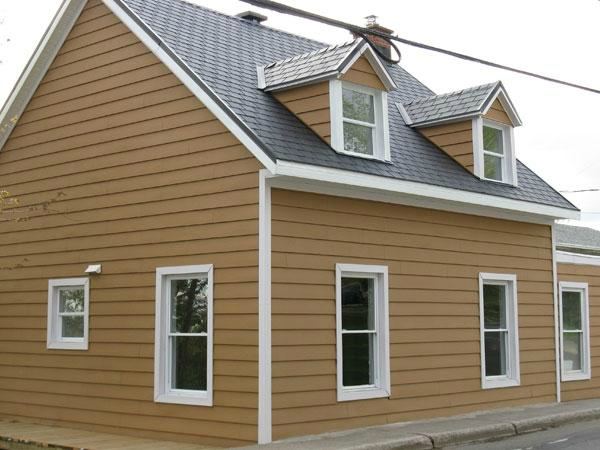





Types of siding:
Wet facade
Wet façade for the decoration of the building has a structure of several layers, each part is responsible for different processes. Most often, this wall cladding consists of three layers - this is the first base reinforced layer, heat-insulating and decorative layers. The reinforced layer is necessary to make the wall smooth and well to fix the thermal insulation, it includes a grid and glue composition.
The thermal insulation layer is responsible for keeping heat in the room and consists of special heat-retaining plates. This material is made of expanded polystyrene and mineral wool. The outer layer is made of plaster and performs not only decorative, but also a protection function.
Than to finish a facade of a building, on a total
There are a lot of options for decorating your facade, each has its pros and cons and has different decorative properties. What is the option to choose for yourself a matter of personal taste and preferences. It all depends on your ability, desire, taste and money. For someone, a cheaper and faster option is more appropriate, and someone is looking for a better and more durable one. The most important thing is that in the end you are happy with the result!
The facade of the house is his heart and soul. On it you can determine not only the wealth and taste of the owner, but also his character, as well as neatness and accuracy. The facade not only serves as a beautiful outer shell, but also protects the house from any troubles. That is why it is necessary to attach maximum attention to its arrangement. And it's not just about beauty, but about quality.
Than to coat the front of the house
Let's start perhaps with the simplest, namely, with the ways of decorating the house. Today there are a lot of them, we can distinguish the most popular:
- wet facade (heavy or light stucco method);
- ventilated (siding, clinker brick);
- stone (natural or artificial).

At once we shall select furnish from a brick or a stone. They look always profitable and rich, giving the building a solid appearance. Such houses are usually performed in warm brown tones, perfectly complemented by a roof in the same shades of bitumen, composite or even natural tiles. But the cost of such mansions is also high.

Finishing the facade of a residential house with a plastering method is probably at the peak of popularity. Thanks to a large assortment of all kinds of materials, everyone can find an option for themselves. And it's not just in appearance, a lot of materials and their combinations will fit into any budget. It will serve a long time, and with a high-quality performance of all the works will retain its appearance, without any flaws for a long time.
Choosing this method of finishing, you get:
- long service life;
- excellent appearance;
- the possibility of creating a unique and unique project;
- greater freedom in design;
- water resistance;
- simplicity in care;
- reliability.
It is because of this that he became one of the most common methods of finishing. And if you are looking for less expensive to trim the front of the house, then among the plasters you will find exactly what you can afford, since their range and the possibility of a combination of auxiliary materials is very large.

Ventilated facade
This method can include not only siding, but also porcelain stoneware, as well as clinker bricks. This method assumes a special installation, with compliance with the ventilation gap and the use of special membranes. In such facades also there is a certain charm and lightness. So, for example, in such design the house in Scandinavian style, with a roof from a bituminous shingles perfectly looks.
But, despite the fact that the materials are being improved every year, there are still a lot of opponents of the siding. As not cool, plastic remains plastic, which means that it is frail. In addition, there is always the risk that unscrupulous workers will perform the installation is not sufficiently high quality. This will entail a violation of the ventilation gap, and accordingly there is a risk of mold or decay. Plus, you need to use special membranes.

The better to insulate the facade
From the methods of external finishing can easily go to the thermal insulation. It is unlikely that now there will be a person who will prove that it is not necessary to insulate the house. Everyone who lives in a private home, in one voice say - it's necessary to do it! In winter, the heat in the house is much better in the house, and in summer the heat does not penetrate inside and keeps a pleasant coolness.
Today the market of thermal insulation materials is presented:
- styrofoam;
- expanded polystyrene;
- mineral wool;
- glass wool.
Of course, among competitors with a large margin exceeds mineral wool. This is a natural material that is made from basalt fiber. It has low thermal conductivity, fire resistance and a long service life. Unfortunately, its cost is higher than that of analogues, but for high quality it is necessary to pay.

How to decorate the facade of a house
In addition to basic finishing works, many people want to decorate the walls of their homes. Here the matter is limited to imagination, courage, and of course, the budget. Below are the most popular options.
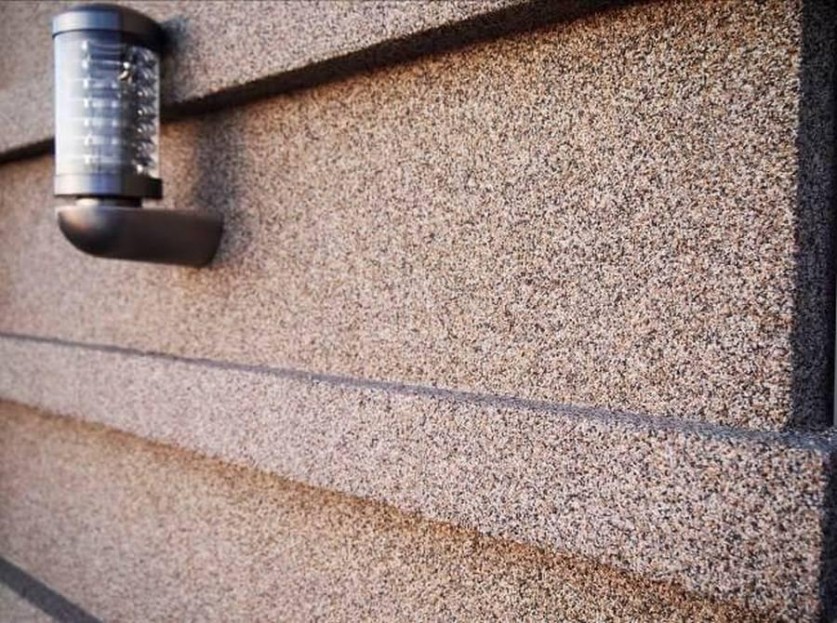
Mosaic. Mosaic plaster for the plinth - a budget and beautiful option. It will help to separate the base of the house, and protect it from contamination.

Socle siding. His goal is the same as that of the mosaic, but it looks richer.

Decorative or artificial stone. This option will be much more expensive, but it will look chic, especially in combination with plaster. A stone can be laid out the base, or simply fragments.

